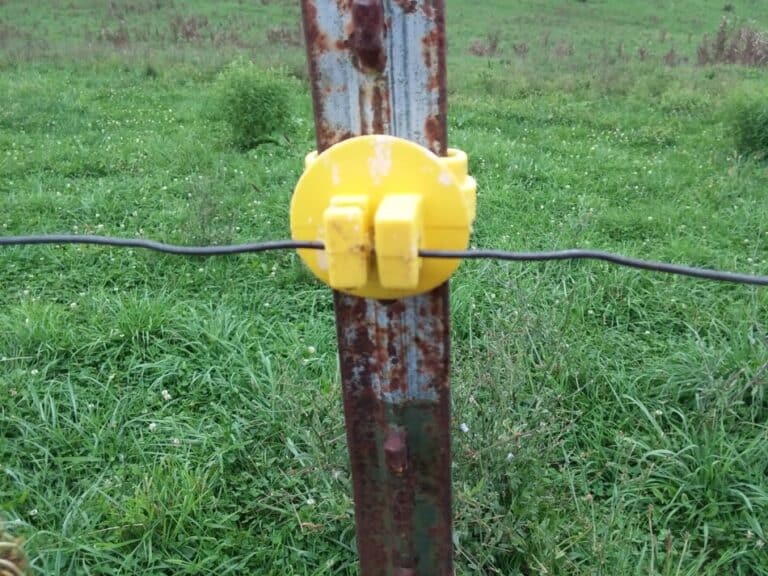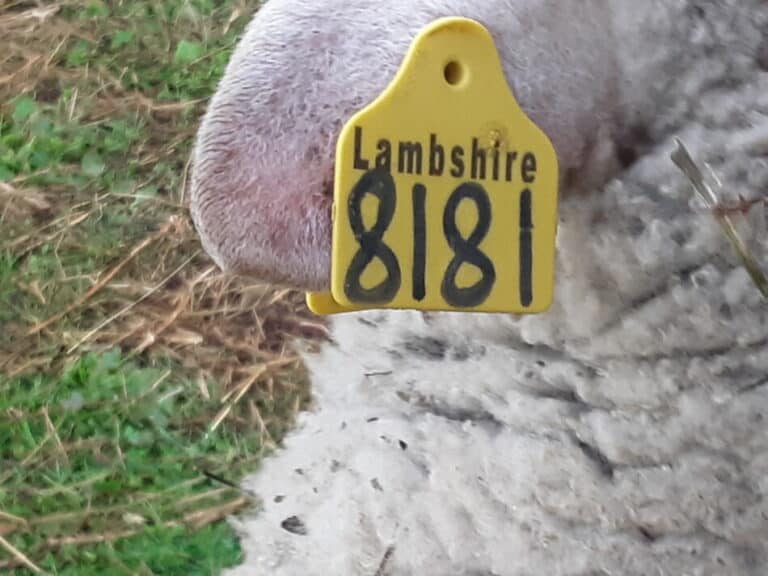5 Best Farm Animals To Raise For Profit

There are multiple animals that you could raise on your farm, but which ones are the most likley to be profitable?
The best farm animals to raise for profit are pigs, small ruminants (sheep or goats), game birds, standard breed roosters and rabbits.
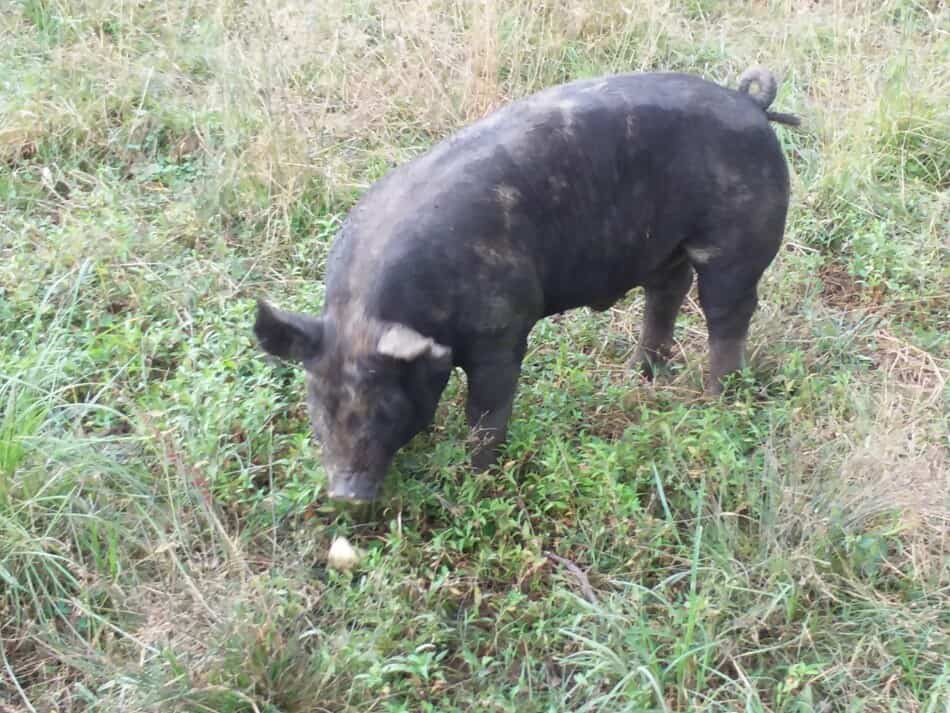
Pigs can be profitable
Potential market: Customers who want great tasting, ethically raised pork.
Pros: Fast growth, 4 months to raise (from feeder size)
Cons: Need sturdy pen, a trailer is required for transport, can be hard to find feeder pigs.
The beauty of pigs are that they can be raised in a smaller area if that is all the space you have available.
How Much Do Pigs Cost? goes over the different types of pigs that sell and how to find their current prices.
Pigs are omnivores.
Since pigs are omnivores, they will eat nearly all of your garden scraps, weeds (don’t throw in the poisonous ones, of course!) and table scraps.
Natural Feeds For Pigs gives you some pig friendly feeding options.
Pigs are amazingly versatile and can be happy eating all kinds of foods.
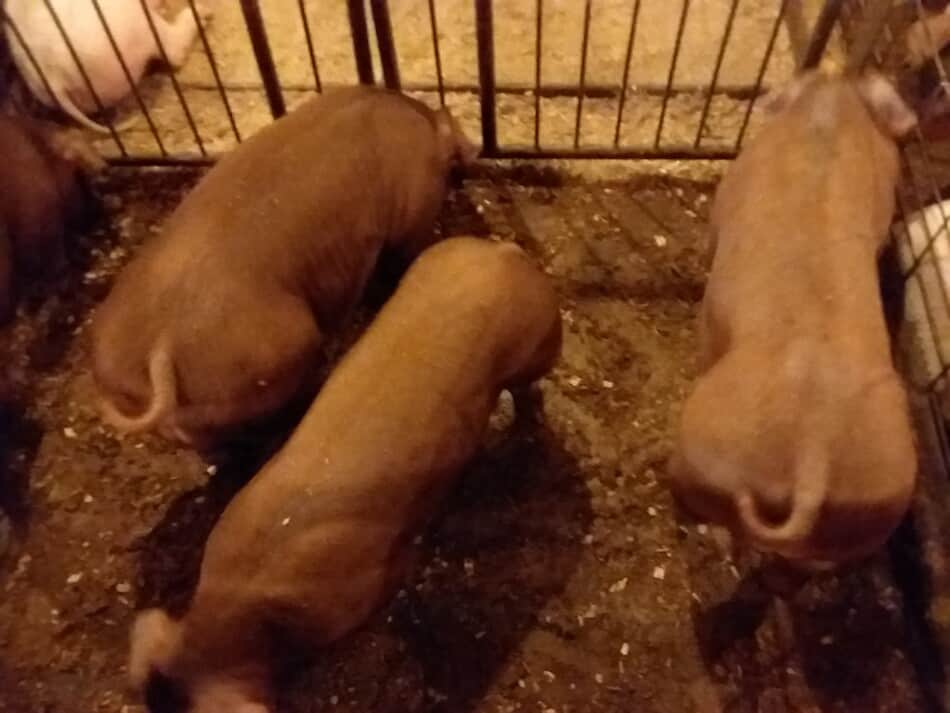
Pigs do not smell.
Before we do any further, let me be clear: pigs should not stink! If yours smell, you are doing something wrong!
Usually the problem is slacking off on bedding or cramming a bunch of pigs into a small area.
Your pigs need room to run around a bit, think of it as an exercise area.
Pigs love pasture and should be given access to it if you have some to spare. They can also do fine in a roomy pen with vegetable scraps and weeds as occasional snacks.
Customers want great tasting pork.
A big plus for the small pig raiser is that the large confinement farms have people looking for alternatives to confinement farmed meat, including pork.
This leaves a huge opportunity for a resourceful person to sell whole or half hogs to friends and neighbors that want to eat high quality, flavorful meat.
You can have a small herd of breeding pigs.
The other huge advantage that pigs have over other animals is that with a few sows and a boar, you can have a litter of feeder pigs to sell from each female, every 6 months all sired by the same boar.
This is a continued source of income from every sow, twice a year.
Feeder pig prices can be seasonal.
If you want other people to want your stock, now you need to think differently, raise what your potential customers want.
In our area, spring born piglets are a hot item, generally bringing much higher prices than the same type of piglets sold in the fall.
Around here this discrepancy in price is due to kids buying fair project pigs in the spring/early summer and locals wanting to raise a few pigs for the family.
Usually butchering is done is the cooler weather of the fall, so people are looking for fat hogs at this time, not piglets to keep for the winter.
Research what type of pig you should raise.
Wondering how things play out in your area?
Check the market reports, most auction houses have been putting their market reports online for a few years now, so you can go back through and see the pricing trend for your area.
You should take in a few auction days, if this is how you plan to sell your stock.
Around us, the chunkier, meatier built pigs sell for significantly more money per head, feeders up through market hogs, as do the more maternally (long and lean) built pigs.
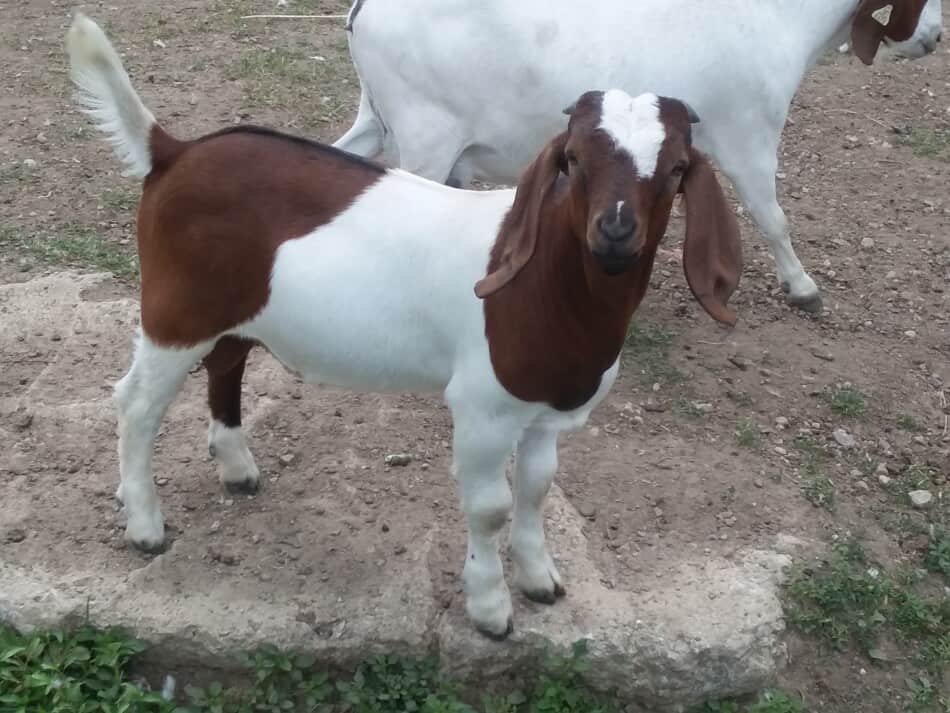
Small Ruminants (sheep or goats)
Potential market: Customers who want superior tasting meat that they can feel good about eating.
Pros: Sheep and goats are small acreage and family friendly livestock. They sell for more money per pound than larger stock and get to selling weight faster.
I write small ruminants rather than being specific about sheep or goats because depending upon your area, the ideal small ruminant for you will be different.
Generally, if it is hot and dry where you live, you should really be thinking goats.
If is is wetter or cooler in your part of the country, you should be considering sheep.
Not only should you be considering the weather, you should also take into account the natural vegetation of your area.
Are Sheep Or Goats More Profitable? walks you through figuring out if sheep or goats will work better for you and your area.
Is there a good amount of brush and briar growth that you want eaten back? That is goat heaven! Depending upon the sheep you have, they may eat the brush a little, but nothing like a goat will.
Are you blessed with great growing grass in your pastures and you need a small grazer? Now you’re talking sheep!
Cons: Not all areas of the country have a noticeable sheep or goat eating population.
Sheep 101 has an overview on making money with sheep, showing the different types of sheep operations.
Goats eat browse.
You’re probably thinking, I’ve seen goats eat grass, what’s she talking about?
Our goats eat grass too, but they also eat all manner of other weeds and forbs the sheep aren’t too happy to taste test.
TennesseeMeatGoats.com is the best goat site around, check it out for any of your more in depth goat questions.
Will goats eat grass? Yes. Can they do well on grass only? No, they like a mix, think of plants you would see a deer eating.
How Much Will My Goats Sell For? shows you where to find the current prices for goats in your area. Even if you are planning to privately sell your goats, you should know the going prices at market.
Sheep eat grass.
Will sheep eat grass only? Yes, and they will thrive on it! Sheep may nibble and taste test here or there but they prefer grass.
This is especially important if you are wanting to use your small flock/herd as lawn mowers, use sheep!
My recommendation is based on which animal will most easily perform well for you, since suiting the animal to the environment you have is always the best way to choose which animals to raise.
Best Animal To Eat Extra Grass goes over why sheep are an excellent choice of animal for anyone with extra grazing.
Get the ruminant suited to your area.
If you live in a wet area and your heart is set on goats, get some! Just be prepared to take a few extra steps to ensure they are able to thrive on your farm.
For instance, in a wet area you will have more parasite problems and hoof trimming issues in goats.
If you live in a hot area and want sheep, get some from a flock that is acclimated to your area.
One of the biggest problems for sheep is heat stress! We are in North central Ohio and have issues with heat every year and we don’t live in a what I would think of as a warm state!
However, the great part about sheep is that they are very cold hardy, where as goats hate the cold.
This is a biological thing, goats do not put on external fat (the kind that keeps animals warm) like sheep and cattle do.
No external fat is a big win in the heat, but a challenge in the cold.
Raising small ruminants is overlooked.
Small ruminants are sometimes overlooked when people are thinking of raising animals, I think people automatically think of cattle rather than their smaller fellow ruminants.
This is a huge missed opportunity, since the area that feeds a cow and calf pair will feed between 5-6 ewes with lambs and the same for goats.
Why does this matter you ask? Easy, small ruminants make you more money per the acreage than cattle (if you are selling both through the livestock auction).
Lamb profit is higher per acre than cattle.
For quick math: let’s say you profit $100 per lamb sold and $400 per calf sold. Those five ewes should give you 7 lambs, which is $700 and the cow will give you one calf which sells for $400 profit.
That’s $300 more for sheep! (And that is not the world’s greatest lambing percentage, you could easily do better.)
Before you get too excited check the market reports for your area, but this is an accurate estimation for here.
Sheep or Cattle is an article I wrote to help folks choose between sheep and cattle, right now, sheep are definitely the better choice!
Buyers will prefer sheep or goats, do your research.
This is another area where you should heavily consider figuring out what your local buyers want before you get sheep or goats!
Each area is different. You need to know the specifics of your area before you put in the time and money with your animals.
Here is an example for my area: lambs from hair sheep tend to sell for less money than wool breed lambs of the same size and quality.
Currently, selling a 50-60 pound fat lamb brings nearly as much money per head as a market lamb, 80-120 pounds.
As far as goats go, Boer and Boer cross are the ticket for getting higher prices, from what I have seen the difference can be as much as $75-100 more per goat that has Boer looks.
A finished dairy type wether will bring decent money when it gets to be full size and well filled out. Smaller than that and they don’t bring much.
In our area, Kiko type goats will sell like a dairy goat, I know in some areas of the country that is not the case, at all.
Game Birds (if you can figure it out)
Potential market: Hunters, dog trainers and customers who enjoy eating a variety of less common meats.
Pros: Game birds sell for significantly more money than barnyard poultry.
Cons: Permits may be required by the state and game birds are challenging to raise.
Game birds sell well.
Game birds sell well and seem to be in constant demand. They are almost too good to be true, notice I wrote “almost”. The catch here is that they can be hard to raise.
If you can make it happen, they are perennial good sellers. Once you have a system figured out, you will be able to produce game birds for years to come.
The great news is that game birds are always in demand, hatch well, even in home incubators and are lively chicks.
MacFarlane Pheasants has an interesting specialty pheasant, bred specifically for meat production!
Game birds are challenging to raise.
The not so great news is that game birds seem to spend all day finding creative ways to hurt themselves or one another.
Never have we had the problems with chicks or ducklings that we have had with game bird chicks.
They are a whole different world of poultry. For us, game birds were always more hassle than they are worth.
Game birds are raised for hunters.
There are multiple game bird farms around here that are successful.
Hunters releasing birds to shoot and needing live birds for dog training will pay pretty well for healthy pheasants and quail.
Game birds sell well at “exotic” auctions.
Game birds also tend to sell well at the spring alternative animal and poultry sales. These used to be called “exotic sales” but the name was changed to “alternative”.
Either way, if you can get your birds to the spring sales, or advertize them before egg laying season, people will pay well for healthy breeding age birds.
Regarding the alternative animal and bird sales, the sales in the fall are never as good as the sales in the spring. Being aware of this is important to keep you on budget!

Standard breed roosters, if you have the market
Potential market: Traditional cooks who want the most chicken flavor.
Pros: Chicks are cheap and don’t require special feed.
Cons: Takes 6-8 months to mature and not all areas will have buyers.
Most people would overlook the rooster as a money maker, but take a second look.
While nearly all roosters at least in our area are raised as flock sires, there is another opportunity, meat sales.
Traditional cooks love to cook rooster.
People who are traditional cooks love rooster! And not just traditional breed chickens, like stewing hens, rooster specifically.
In our area, north central Ohio, a mature rooster sells for $12-14 each at the weekly sales. An especially beautiful one will sell for over $20.
This is at the regular sales, meaning these birds are being resold to the eaters!
Can You Eat Rooster? shows you that rooster is actually quite popular, at least with the traditional cooks we know!
Smaller sized roosters sell well, too.
Another commonly overlooked option is 8-12 week old traditional breed roosters, people love these.
They are smaller sized, since they need to be 6-8 months old to get to full size, but these smaller roosters are popular as well.
These smaller sized roosters sell for $6 each at the flea market sales. Through the auction they are very hit or miss.
Private sales are definitely the way to go here!
Rooster chicks are cheap.
The first reason roosters are money makers is the price of the chick, we get them for $0.34 each at the hatchery. If you watch the auctions or look around online, my guess is you can do better than that!
These roosters take the same amount of feed as a female chick to get to full size, yet will sell for half again as much money!
How To Choose A Chicken Hatchery shows you the points to consider when ordering your birds.
Roosters take longer to raise.
Compared to most other poultry, roosters do take longer to raise to selling age. Even if you are selling the half grown ones, it will still be three months or so until they are of sellable size and weight.
For the full size, high selling roosters, it is 8-12 months, depending upon the breed.
Research your market for roosters.
The down side here is that you would need to space out the rooster selling over a period of sales to keep your price high. That adds time.
If you were to dump all of your 200 roosters on one sale, your price is going to be low, very low.
If you can take 5-10 at a time, you’ll keep the price high. Once again, this depends upon your area.
The other caution to be aware of is maxing out the local market. You’ll need to figure out how many roosters people are willing to consistently pay well for.
This means if you seem to max out at 10 per week, this is not much total money. If you can privately sell, you can move however many roosters your customers are willing to buy.
Once again the challenge of lower profit per head, compared to a larger animal, is going to be your issue.
Meaning you’ll need to sell 10-12 roosters to profit the same as one lamb, etc.
Roosters raised together do not fight.
I’m sure you are concerned with the roosters fighting, in our experience they don’t. To be fair, we have given them plenty of space and an appropriate diet, to keep them as healthy as possible.
Poor diet can promote behavior problems. Crowding definitely promotes behavior issues!
Know the price for rooster at the closest ethnic market.
A word of caution: before you go crazy here please research your market. If there is a reasonably close ethnic food store, go see what they have!
Our area is close enough to Columbus, which has a large immigrant population. These traditional cooks are looking around for chicken like they are used to back home (not broilers).
We also have a fair number of households and restaurants that want authentic Mexican food, meaning tasty chicken (not broilers).
If you do not have traditional cooks in your area, who will buy your roosters? I’m sure someone will, but you won’t like the price!
Make sure you have the interested eaters before you get a ton of chicks!
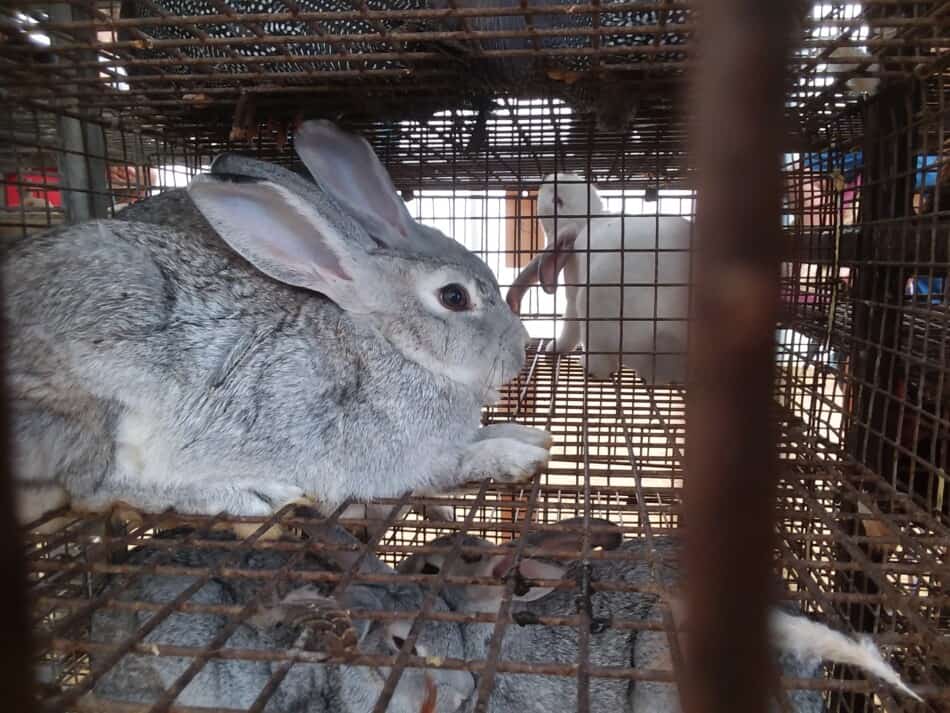
Rabbits are backyard superstars
Potential market: Customers who grew up eating rabbit want great tasting rabbit dinners again.
Pros: Rabbits are quiet and small acreage friendly.
Cons: Demand for rabbit meat is very regional and finding a processor may be difficult.
Be sure to know your market and area preferences.
Is Raising Rabbits For Meat Worth It? goes over the costs to buy your own rabbits and find the current meat prices in your area or online.
Do customers in your area eat rabbit?
In my area of Ohio, not too many people eat rabbit and the idea of raising rabbit for meat is not very popular.
I have always found this to be odd, since rabbit projects including the market rabbits are very popular at the local fairs.
The point here is that you need to look in the meat section of your local stores and ask around to potential customers to see what they are looking for.
If your area of the country loves to eat rabbit, this is a golden opportunity for you! If the locals do not like the idea of rabbit for dinner, it will be wise to find out where to sell your rabbits before you get them!
Rabbits are ideal for small acreages.
The beauty of raising rabbits is that they can be raised nearly anywhere, small backyards or in part of the garage.
It is amazing how much meat a trio of meat rabbits can produce in a year! And the crazy part is, all in 5 cages! (One cage for each adult rabbit plus one cage for the fryers from each doe.)
Click here for my article on the number of rabbits for a family of four.
Rabbit feed is easy to find all over the country and rabbits have the best feed conversion of any meat animal that is commonly raised at home!
Fryers have a 3 to 1 feed to gain ratio. (This means they need to eat three pounds of feed to gain one pound of weight.)
Cages or hutches can be purchased or built and are commonly available online, be sure to look over your local ad listings, or in nearly any farm store.
Have a plan for rabbit processing.
Be sure that you are willing to do your own processing.
It may be very difficult to find a processor in your area and they may or may not have room in their schedule for your rabbits!
We have a poultry processor about an hour from here that normally does rabbits for $5.00 each.
With the crazy high demand for processing this year, they are not doing rabbits until business slows in the winter.
Raise what the customer will buy
Raising more of the same thing everyone else in your area raises, the same way they raise it will get you about the same results as they are getting.
This is fine, if you are raising animals for a hobby.
Or, if you plan to raise your own meat, no worries. Raise what you want to eat!
The golden opportunity here is to raise the animals that your potential customers want that also suit your area and resources. Now that will be profitable!
Before you decide to buy anything, research your area. What are people looking for? You need to fill a currently unfilled need for your local or regional customers.
Animals that have potential but didn’t make the list
If people in your area value any of the following items, these are all great potential opportunities.
Eggs: chicken or duck
Broilers
Raw milk sales/herd share: which you do depends upon your state. I know of a few herd share places doing very well and others that never seem to take off. Herd share/raw milk could be cow or goat.
Beef cattle: right now beef cattle are not selling well through the auctions! However, people with private sales are doing very well and are consistently selling out!
Please note:
- all of these suggestions are based on my experience in my area. You’ll need to do some research to find the best choice for you.
- anytime you can private sale, whole or half, you’ll make significantly more profit per animal than selling at an auction. The increased pay is in return for extra time you spend with customers. Retail cuts, even more so, but require more from you like all of the costs of butchering paid by you and you are keeping them in sell able condition (freezer, customer appropriate areas, etc.)

